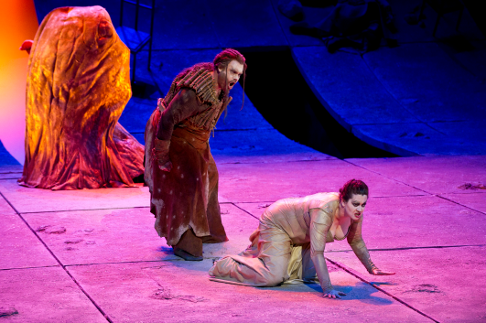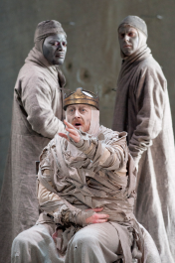Even
though I began to harbour doubts about some aspects of Nikolaus
Lehnhoff’s production, above all its ending, it remains preferable to
many I have seen in the meantime. Stefan
Herheim’s astounding Bayreuth version stands in a class of its own.
Leaving that aside, however, Lehnhoff is immeasurably superior, say, to the
pitiful, incoherent offeringsfrom Klaus
Michael Grüber for Covent Garden — why on earth did the Royal Opera
revive a universally derided non-production? — or Bernd
Eichinger’s confused effort for the Berlin State Opera, let alone
glimpses of Tony
Palmer’s cod-mediævalism for the Mariinsky. Lehnhoff’s
conception, powerfully aided by Raimund Bauer’s stage designs, stands
very much in the shadow of the Holocaust, taking as a further, generally
productive cue the Waste Land’s ‘heap of broken
images’. Apposite both to Wagner’s drama ‘in itself’
and to how we may now feel compelled to consider it, we encounter in the first
act a community clearly in need of rejuvenation; by the time of the third act,
much has turned to rubble and stone, it not being clear until the end whether
there should remain any hope at all, even under Parsifal, of that rejuvenation.
The second act seems less sure of itself, its abiding images being the bizarre
costumes Andrea Schmidt-Futterer allots to Klingsor (weirdly space-age) and
Kundry (a strange chrysalis, out of and into which she awkwardly squeezes
herself). But compared to the horrors of Grüber’s Covent Garden
production, we perhaps should not concern ourselves unduly with that. What the
whole lacked, I thought, was more incisive direction on stage, doubtless a
consequence of Lehnhoff’s absence through illness: there was more than
the occasional hint of a routine ‘revival’, a great pity given the
ideas presented.
The broken railway line present during the whole of the third act is a
powerful ‘broken image’, presumably intended to refer to Auschwitz.
But what is being said there? That the variety of revival offered by the
community’s new leader leads to racial rather than Schopenhauerian
annihilation? That would be wrong-headed in the extreme, but a point of view at
least, yet it seems undercut by the joy with which Kundry — she does not
die — and Parsifal begin their journey along the line. The implication
seems to be that they are wandering off to initiate a sexual relationship:
bewildering, and arguably offensive, in the production’s context. The
production, understandably, appears to waver between a quasi-Adornian attempt
to ‘rescue’ Wagner and a desire to condemn him. Part of the reason,
I suspect, why this conundrum presents itself is the production’s
absolute refusal to engage with the work’s complex relationship towards
Christianity. (I should direct anyone interested in my thoughts on the latter
to an article in The Wagner Journal, 3/3, pp.29-59.) Simply to ignore
the issue seems to me an unduly easy way out. And yes, that includes the
deflating absence of any substitute for the second-act Sign of the Cross; text
and music cry out for something, whatever it might be.
Mark Wigglesworth’s conducting was for the most part something to
savour. Parsifal is by any standards a tough proposition, but the
structure was largely in place, most impressively of all in the first act,
which opened with a beautifully slow yet sustained prelude. The third act
occasionally dragged: not a matter of tempo as such, but of faltering line;
however, I should not wish to exaggerate. The score’s dialectic between
horizontal and vertical demands was more surely navigated than I have often
heard. Moreover, the ENO orchestra gave perhaps the finest performance I have
ever heard from it; I have certainly never heard it finer. Strings had weight,
sweetness, and silkiness, as required, whilst the rounded tone of the brass,
sepulchral and never brash, proved exemplary.
 Stuart Skelton as Parsifal and Jane Dutton as Kundry
Stuart Skelton as Parsifal and Jane Dutton as Kundry
Allowances had to be made for some of the vocal portrayals — and for
almost all of Richard Stokes’s English translation. The latter is
doubtless an horrendously difficult task to undertake, but some of the
inaccuracies — why change a gander to a ‘duckling’, making
nonsense of the relationship to a goose? — and banalities could surely
have been improved upon. Choral singing was generally very good. Jane
Dutton’s Kundry was sadly below par; one could only regret the absence,
owing to ‘artistic differences’, of the originally advertised Iréne
Theorin. Sir John Tomlinson’s voice is becoming increasingly threadbare
at the top, but there was no denying the overall majesty of his Gurnemanz,
however impoverished the great narrations may have been by the act of
translation. Iain Paterson had a slightly shaky start as Amfortas, but
recovered well, soon erasing unfortunate memories of his bizarre miscasting by
ENO as Don Giovanni; here, instead, we had a typically detailed response to
text and music, and a credible dramatic assumption, for the most part finely
acted on stage. Tom Fox and Andrew Greenan made their respective marks without
blemish as Klingsor and Titurel, both rising vocally above the handicap of
their strange costumes. Stuart Skelton displayed a fine Heldentenor in
the title role, very much in the baritonal, ‘Bayreuth’ tradition.
As with many of the best exponents of the role, he left one initially a little
disappointed, an apparent disappointment rectified by the appreciation of
dramatic strategy: the first act Parsifal should sound somewhat
vacant, in order to allow for the extraordinary development the character
undergoes. (Even ‘extraordinary’ is to put it mildly.) The voice
lacks nothing in power; if anything, the thought occurred that it might have
benefited from a larger space.
 Iain Patterson as Amfortas, Adrian Dwyer as First Knight and Robert Winslade Anderson as Second Knight
Iain Patterson as Amfortas, Adrian Dwyer as First Knight and Robert Winslade Anderson as Second Knight
Indeed, I still wonder whether a theatre other than the Bayreuth
Festspielhaus is a suitable venue for staging Parsifal at all: not out
of misplaced ‘Bayreuth Idealist’ piety, but rather because I think
other, non-theatrical spaces, from Siena Cathedral to the Tate Modern Turbine
Hall, might prove much more appropriate. A work that has so far transcended the
narrow horizons of the Italianate opera house — or, in the case of the
Coliseum case, the music hall! — jars somewhat in such a setting. Whether
one considers that jarring productive may be a matter of taste, however, and
the problem, such as it is, is not ENO’s alone; far from it.
Mark Berry
![Stuart Skelton as Parsifal [Photo by Richard Hubert Smith courtesy of English National Opera]](http://www.operatoday.com/Parsifal_Stuart_Skelton_credit_Richard_Hubert_Smith.png)

